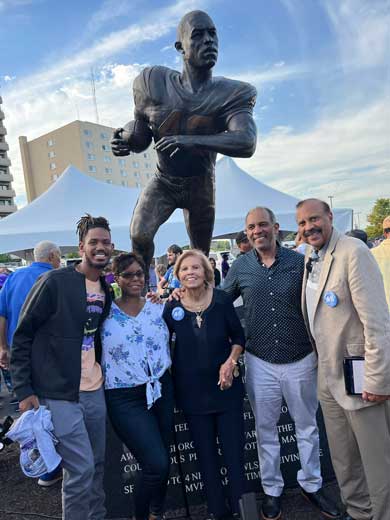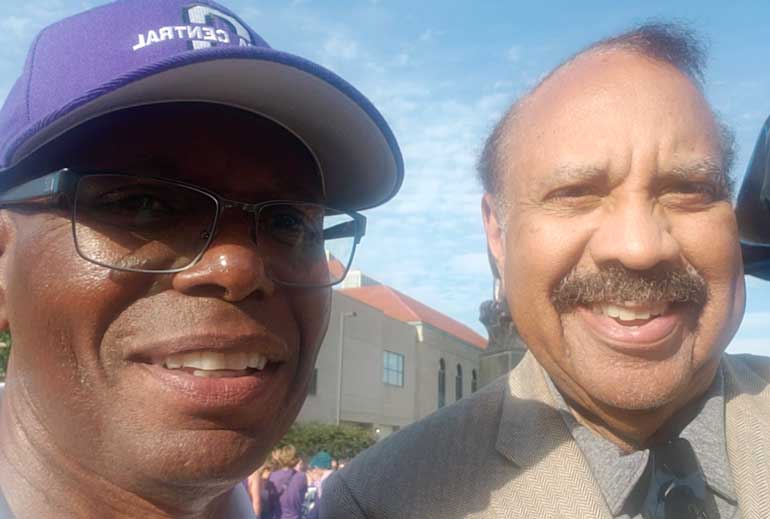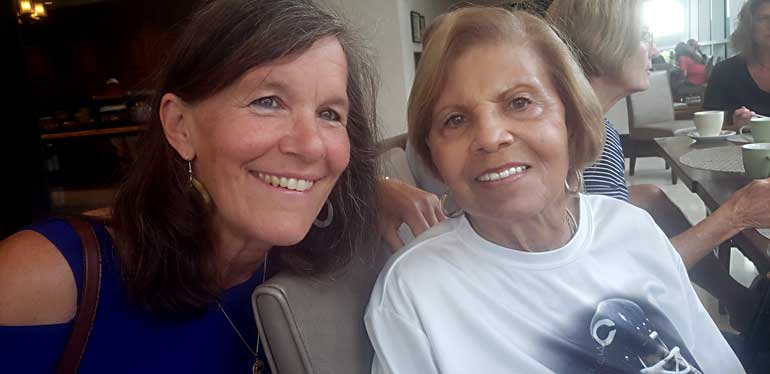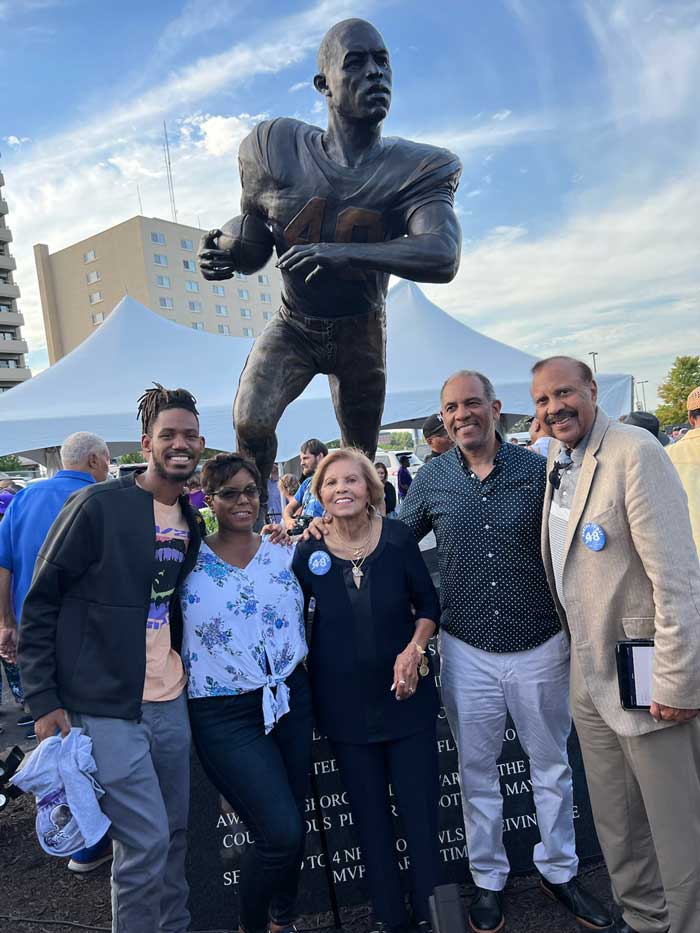The recent dedication of a Gale Sayers statue in Omaha, Neb., offered a precious opportunity for friends and longtime acquaintances to extend emotional support for the Sayers family.
Sayers, who passed away Sept. 23, 2020, was an iconic Hall of Fame running back for the Chicago Bears who was further immortalized because of his relationship with teammate Brian Piccolo. They became the first known interracial roommates in professional sports. After Piccolo died of a rare form of cancer at the age of 26, the movie “Brian’s Song” brilliantly depicted their unique and deeply caring relationship.
Sayers, a first-round draft pick out of Kansas in 1965, has been honored with statues at his alma mater and now Omaha Central High School, where he starred as a prep football and track athlete.
“It was a long time waiting for this; it was bittersweet. But I enjoyed it; I appreciated it,” said Sayers’ widow, Ardie, following the statue unveiling ceremony on Aug. 26th. “And I think Gale would have too. I could just hear him looking at it and saying: ‘I like it! I like it!’ …I know he would be honored and humbled by it and thankful to the committee, the high school and their staff. Everyone did a beautiful job with the whole ceremony. His brother (Roger) and everyone who got up and talked about Gale…it was wonderful.”

I was honored to share in the statue ceremony with Ardie Sayers (center) and members of her family.
Roger Sayers, the older brother of Gale and a 1960 graduate of Omaha Central, delivered a moving tribute to Gale.
“I hold the distinct honor of teaching Gale everything he knew,” Roger joked as the audience laughed and applauded. Roger, who was a world-class track athlete, also acknowledged the presence his brother Ron and his family, who were in attendance. Ron played briefly with the San Diego Chargers.
“What was not often written were Gale’s accomplishments after football,” Roger told the group. “After Gale finished his all-too-short professional football career, he returned to Kansas and completed his bachelor’s degree in physical education. While he was doing this, he was working as the assistant athletic director. He took over one of the major fundraising programs at KU, while earning his master’s degree in educational administration. He left KU in 1976 to become the athletic director at Southern Illinois University. In 1982, Gale moved back to Chicago and launched a sports marketing and public relations firm with his wife, Ardie. It was called ‘Sayers Enterprise.’
“After all of the success he had already accomplished, Gale launched a computer supply business in 1984. This business became a world-class provider of technology products. And it was one of the premier minority businesses in the United States.”
Among the many friends, family and acquaintances who traveled to Omaha for the statue unveiling was Chris Halas, the granddaughter of Chicago Bears founder and coach George Halas.
“I love Ardie and Gale,” Chris Halas told me.
“Gale was drafted the year I was born- 1965. So I never saw him play. But when I was young, ‘Brian’s Song’ was on the TV. So we watched it. I loved watching Jack Warden interpret my grandfather and how the movie made me feel. As a young child it planted a seed of love in my heart in a different way. I wouldn’t have phrased it this way at 5 or 6 years old, but I see that movie demonstrates a different possibility for humanity compared to the systemically racist society that we were all born into…that was the first part.
“Then my grandfather and my Dad (the late George Jr. “Mugs” Halas) took me and my brother to Canton, Ohio, when my grandpa inducted Gale Sayers into the Hall of Fame. I could hear and feel the love he had for Gale. And it was palpable. I was 12 then in 1977.
“When I was in high school, I read ‘I am Third.’ So that of course continued to educate me about a lot of things. So knowing how much my grandfather loved Gale…when I became in a position to do something to honor Gale’s legacy, I rang him up. I said: ‘Hello, Mr. Sayers. This is George Halas’s granddaughter here. I’d like to start a scholarship at the University of Iowa.’ So we went to lunch and we created the Halas-Sayers scholarship, which is a full-ride scholarship for students of color from Iowa and Illinois to attend the University of Iowa.”
Given the benefit of time and reflection, Chris Halas appreciates the foresight and courage of her grandfather.
“He was visionary,” she said. “To put Gale Sayers and Brian Piccolo as roommates when that wasn’t done was visionary. And love blossomed. That space to do what society says shouldn’t be done and that vision of bringing people together is precious. A lot of people said George Halas threw nickels around like manhole covers. But I also learned from him that when you do something, you do it anonymously because it is not about you.”
Chris Halas said she felt that it was incredibly important to attend the August 26th bronze statue unveiling in Omaha. Gale’s brother, Roger, was surprised when sculptor Littleton Alston presented him with a smaller statue of him. Other speakers included Michele Roberts, Central High School Foundation Executive Director; Mike Lebens, Central High School Foundation president; Ms. Dionne Kirksey, Central High principal and Charlie Yale, sports editor for the Central High School newspaper.

Roger Sayers and me.

Chris Halas, granddaughter of Bears founder and coach George Halas, is a major supporter of Ardie Sayers.
“I hope people really remember Gale Sayers and the Sayers family,” Chris said. “Because they are a classy, amazing, phenomenal family which puts love in action. I would also ask people to be humble in what they think they know. Because power works to divide us. And that space of pitting people against each other is a tactic as old as time. And people fall for it. Be willing to talk to people. Reach across the divides which are artificially instituted to keep those in power in power.
“Gale’s time and energy, whether it was with kids or the Sayers Foundation…I would hope that legacy would continue through all of our actions. As I said when I was blessed to speak at Gale’s funeral in Indiana: To folks who look like me, it’s our job to dismantle white body supremacy. To use kindness, compassion and love in action every day…that would be a beautiful testimony to Gale and his legacy. And it would make our world a better place.”
Ardie Sayers sounded emotional as she acknowledged the presence of Chris Halas and so many others from across the country.
“It’s wonderful and I just feel we are blessed,” Ardie said. “Because Chris is a fighter for human rights. And she just doesn’t talk about it. She lives it. And that’s what we need. Communicate with your fellow man. Respect each other. And there are many others who came from North Dakota and Kansas City, Chicago and California, Indiana, Texas…it really made me feel good that people cared that much that they would take the time to come and celebrate what Gale has done…and to give me help and let me know that they are here to help me in whatever way they can. And to help me continue Gale’s legacy…that’s wonderful.”
The statue unveiling ceremony that was held next to the high school football stadium where Gale once starred, carried on later with a special dinner held at the school. Stories were shared, hugs were plentiful and intermittent smiles and tears were prevalent as the memories of Gale Sayers dominated conversations.
“We who loved him have to make sure his legacy is carried on and continue to do the things that he wanted to do,” Ardie said. “And that was mainly to help young people have a better life and go in the right direction. Gale would always say: ‘God is first, my family and friends are second, and I am third.’ That is something we all need to practice and try to do.”
The recent dedication of a Gale Sayers statue in Omaha, Neb., offered a precious opportunity for friends and longtime acquaintances to extend emotional support for the Sayers family.
Sayers, who passed away Sept. 23, 2020, was an iconic Hall of Fame running back for the Chicago Bears who was further immortalized because of his relationship with teammate Brian Piccolo. They became the first known interracial roommates in professional sports. After Piccolo died of a rare form of cancer at the age of 26, the movie “Brian’s Song” brilliantly depicted their unique and deeply caring relationship.
Sayers, a first-round draft pick out of Kansas in 1965, has been honored with statues at his alma mater and now Omaha Central High School, where he starred as a prep football and track athlete.
“It was a long time waiting for this; it was bittersweet. But I enjoyed it; I appreciated it,” said Sayers’ widow, Ardie, following the statue unveiling ceremony on Aug. 26th. “And I think Gale would have too. I could just hear him looking at it and saying: ‘I like it! I like it!’ …I know he would be honored and humbled by it and thankful to the committee, the high school and their staff. Everyone did a beautiful job with the whole ceremony. His brother (Roger) and everyone who got up and talked about Gale…it was wonderful.”

I was honored to share in the statue ceremony with Ardie Sayers (center) and members of her family.
Roger Sayers, the older brother of Gale and a 1960 graduate of Omaha Central, delivered a moving tribute to Gale.
“I hold the distinct honor of teaching Gale everything he knew,” Roger joked as the audience laughed and applauded. Roger, who was a world-class track athlete, also acknowledged the presence his brother Ron and his family, who were in attendance. Ron played briefly with the San Diego Chargers.
“What was not often written were Gale’s accomplishments after football,” Roger told the group. “After Gale finished his all-too-short professional football career, he returned to Kansas and completed his bachelor’s degree in physical education. While he was doing this, he was working as the assistant athletic director. He took over one of the major fundraising programs at KU, while earning his master’s degree in educational administration. He left KU in 1976 to become the athletic director at Southern Illinois University. In 1982, Gale moved back to Chicago and launched a sports marketing and public relations firm with his wife, Ardie. It was called ‘Sayers Enterprise.’
“After all of the success he had already accomplished, Gale launched a computer supply business in 1984. This business became a world-class provider of technology products. And it was one of the premier minority businesses in the United States.”
Among the many friends, family and acquaintances who traveled to Omaha for the statue unveiling was Chris Halas, the granddaughter of Chicago Bears founder and coach George Halas.
“I love Ardie and Gale,” Chris Halas told me.
“Gale was drafted the year I was born- 1965. So I never saw him play. But when I was young, ‘Brian’s Song’ was on the TV. So we watched it. I loved watching Jack Warden interpret my grandfather and how the movie made me feel. As a young child it planted a seed of love in my heart in a different way. I wouldn’t have phrased it this way at 5 or 6 years old, but I see that movie demonstrates a different possibility for humanity compared to the systemically racist society that we were all born into…that was the first part.
“Then my grandfather and my Dad (the late George Jr. “Mugs” Halas) took me and my brother to Canton, Ohio, when my grandpa inducted Gale Sayers into the Hall of Fame. I could hear and feel the love he had for Gale. And it was palpable. I was 12 then in 1977.
“When I was in high school, I read ‘I am Third.’ So that of course continued to educate me about a lot of things. So knowing how much my grandfather loved Gale…when I became in a position to do something to honor Gale’s legacy, I rang him up. I said: ‘Hello, Mr. Sayers. This is George Halas’s granddaughter here. I’d like to start a scholarship at the University of Iowa.’ So we went to lunch and we created the Halas-Sayers scholarship, which is a full-ride scholarship for students of color from Iowa and Illinois to attend the University of Iowa.”
Given the benefit of time and reflection, Chris Halas appreciates the foresight and courage of her grandfather.
“He was visionary,” she said. “To put Gale Sayers and Brian Piccolo as roommates when that wasn’t done was visionary. And love blossomed. That space to do what society says shouldn’t be done and that vision of bringing people together is precious. A lot of people said George Halas threw nickels around like manhole covers. But I also learned from him that when you do something, you do it anonymously because it is not about you.”
Chris Halas said she felt that it was incredibly important to attend the August 26th bronze statue unveiling in Omaha. Gale’s brother, Roger, was surprised when sculptor Littleton Alston presented him with a smaller statue of him. Other speakers included Michele Roberts, Central High School Foundation Executive Director; Mike Lebens, Central High School Foundation president; Ms. Dionne Kirksey, Central High principal and Charlie Yale, sports editor for the Central High School newspaper.
“I hope people really remember Gale Sayers and the Sayers family,” Chris said. “Because they are a classy, amazing, phenomenal family which puts love in action. I would also ask people to be humble in what they think they know. Because power works to divide us. And that space of pitting people against each other is a tactic as old as time. And people fall for it. Be willing to talk to people. Reach across the divides which are artificially instituted to keep those in power in power.
“Gale’s time and energy, whether it was with kids or the Sayers Foundation…I would hope that legacy would continue through all of our actions. As I said when I was blessed to speak at Gale’s funeral in Indiana: To folks who look like me, it’s our job to dismantle white body supremacy. To use kindness, compassion and love in action every day…that would be a beautiful testimony to Gale and his legacy. And it would make our world a better place.”
Ardie Sayers sounded emotional as she acknowledged the presence of Chris Halas and so many others from across the country.
“It’s wonderful and I just feel we are blessed,” Ardie said. “Because Chris is a fighter for human rights. And she just doesn’t talk about it. She lives it. And that’s what we need. Communicate with your fellow man. Respect each other. And there are many others who came from North Dakota and Kansas City, Chicago and California, Indiana, Texas…it really made me feel good that people cared that much that they would take the time to come and celebrate what Gale has done…and to give me help and let me know that they are here to help me in whatever way they can. And to help me continue Gale’s legacy…that’s wonderful.”
The statue unveiling ceremony that was held next to the high school football stadium where Gale once starred, carried on later with a special dinner held at the school. Stories were shared, hugs were plentiful and intermittent smiles and tears were prevalent as the memories of Gale Sayers dominated conversations.
“We who loved him have to make sure his legacy is carried on and continue to do the things that he wanted to do,” Ardie said. “And that was mainly to help young people have a better life and go in the right direction. Gale would always say: ‘God is first, my family and friends are second, and I am third.’ That is something we all need to practice and try to do.”

Roger Sayers and me.

Chris Halas, granddaughter of Bears founder and coach George Halas, is a major supporter of Ardie Sayers.
Video of the unveiling of the Gale Sayers statue in Omaha, Neb.
